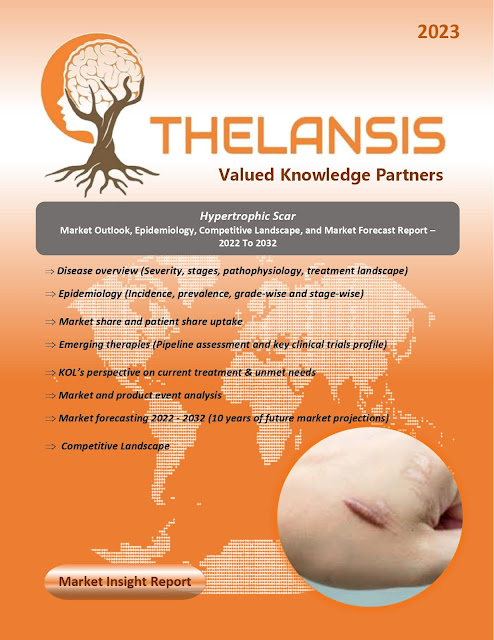Hypertrophic Scars – Market Outlook, Epidemiology, Competitive Landscape, and Market Forecast Report – 2022 To 2032
Hypertrophic scars are characterized as elevated, red-colored, itchy lesions that remain within the confines of the original wound area. They often start with a brownish-red hue but can fade as they age. Unlike keloids, these scars are generally less nodular and don't protrude more than 4 mm above the skin's surface. The formation of hypertrophic scars usually begins about six to eight weeks after an injury and stabilizes around six months afterward. Notably, they tend to manifest more frequently on extensor surfaces such as the elbows and knees, and if they develop over joints, they can lead to restrictive contractures. Spontaneous regression is possible without any intervention, and the severity of scarring is closely linked to the depth and site of the injury. When addressing hypertrophic scars, steroids are commonly employed as the primary treatment option for this type of scarring, though a definitive cure is not straightforward. Steroids can be administered through injections or direct topical application. Surgical removal is another approach for managing these scars. Typically, steroid injections are combined with surgical procedures and may continue for up to two years after the surgery to promote optimal healing and minimize the chances of recurrence. The prognosis for hypertrophic scarring is generally more favorable compared to keloids. These scars usually emerge soon after an injury and may increase in size for a period before gradually regressing on their own. They tend to respond better to treatments with a lower likelihood of recurring, often requiring only a single treatment approach.
·
Adolescents and pregnant women are more
susceptible to developing hypertrophic scars. It is estimated that
approximately 70% of deep (full-thickness) burn injuries result in the
formation of hypertrophic scars.
Thelansis’s “Hypertrophic Scars Market
Outlook, Epidemiology, Competitive Landscape, and Market Forecast Report – 2022
To 2032" covers disease overview, epidemiology, drug utilization,
prescription share analysis, competitive landscape, clinical practice,
regulatory landscape, patient share, market uptake, market forecast, and key
market insights under the potential Hypertrophic Scars treatment modalities
options for eight major markets (USA, Germany, France, Italy, Spain, UK, Japan,
and China).
KOLs insights
of Hypertrophic Scars across 8 MM market from the centre of Excellence/ Public/
Private hospitals participated in the study. Insights around current treatment
landscape, epidemiology, clinical characteristics, future treatment paradigm,
and Unmet needs.
Hypertrophic Scars Market Forecast Patient
Based Forecast Model (MS. Excel Based Automated Dashboard), which Data Inputs
with sourcing, Market Event, and Product Event, Country specific Forecast
Model, Market uptake and patient share uptake, Attribute Analysis, Analog
Analysis, Disease burden, and pricing scenario, Summary, and Insights.
Thelansis Competitive Intelligence (CI) practice
has been established based on a deep understanding of the pharma/biotech
business environment to provide an optimized support system to all levels of
the decision-making process. It enables business leaders in forward-thinking
and proactive decision-making. Thelansis supports scientific and commercial
teams in seamless CI support by creating an AI/ ML-based technology-driven
platform that manages the data flow from primary and secondary sources.




Comments
Post a Comment